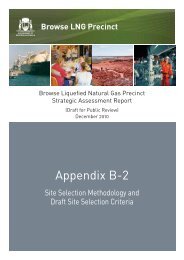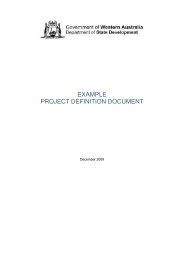Browse LNG Precinct - Public Information Booklet - Department of ...
Browse LNG Precinct - Public Information Booklet - Department of ...
Browse LNG Precinct - Public Information Booklet - Department of ...
You also want an ePaper? Increase the reach of your titles
YUMPU automatically turns print PDFs into web optimized ePapers that Google loves.
<strong>Public</strong> <strong>Information</strong> <strong>Booklet</strong><br />
What is the area <strong>of</strong> land required for shore crossing?<br />
A shore crossing for an <strong>LNG</strong> facility at the <strong>Precinct</strong> is critical for the operation <strong>of</strong> the<br />
facility. The shore crossing across the beach and associated corridor connecting it to the<br />
main <strong>LNG</strong> facility is required to carry several important pieces <strong>of</strong> infrastructure. There are<br />
two types <strong>of</strong> corridors required for the <strong>LNG</strong> <strong>Precinct</strong>. The first is for the pipelines coming<br />
from the gas fields <strong>of</strong>fshore and include:<br />
� Multiple large pipelines that carry the gas and liquids in from the gas field (and<br />
<strong>of</strong>fshore facilities). As these are high pressure gas pipelines they need to meet<br />
appropriate safety requirements to ensure they are appropriately separated from<br />
each other; roads and areas <strong>of</strong> public access.<br />
� Return lines that pump the chemicals recovered from the liquid stream back <strong>of</strong>fshore<br />
to the gas fields. This primarily consists <strong>of</strong> Monoethylene Glycol (MEG) which is an<br />
anti-freeze very similar to what is put in car radiators in colder climates.<br />
The large pipelines need to cross the shore a safe distance from the area that ships will<br />
operate in to maintain safety <strong>of</strong> the facilities.<br />
The second type <strong>of</strong> corridor is for the loading the <strong>LNG</strong> onto ships and connecting the<br />
<strong>LNG</strong> facilities to the Materials Offloading Facility (MOF). The items in this corridor include:<br />
� <strong>LNG</strong> loading lines are required to carry the <strong>LNG</strong> from the tanks to the ship and gas<br />
(<strong>LNG</strong>) vapour from the ship back to the <strong>LNG</strong> facility. Consequently two lines are<br />
needed for each berth;<br />
� Condensate (light oil) loading lines are required to load the condensate from the<br />
storage tank out to the loading berth;<br />
� Liquefied Petroleum Gas (LPG) loading lines need to be allowed for in case a future<br />
proponent produces LPG if it needs to be removed from the gas to meet the <strong>LNG</strong><br />
specification requirements;<br />
� A haul road is needed to connect the Materials Offloading Facility to the <strong>LNG</strong> plant<br />
to carry the large modules (potentially up to 10,000 tonnes) up to the <strong>LNG</strong> facility.<br />
This haul road requires about 75 metres (82 yards) <strong>of</strong> width);<br />
� Access road to the jetty for workers and maintenance equipment;<br />
� Various other utilities also need to be supplied including power, water,<br />
communications, etc.<br />
As the <strong>Precinct</strong> is designed to be expanded in the future the corridor and beach crossing<br />
has to allow enough room for the facilities that will already be operating and the<br />
installation <strong>of</strong> the new facilities to support expansion while the existing facilities remain in<br />
use. For example when a new pipeline from the sea is pulled ashore this cannot occur<br />
too close to an existing pipeline that is already operating so that the safety <strong>of</strong> the workers,<br />
community and environment is maintained.<br />
5279225 56









